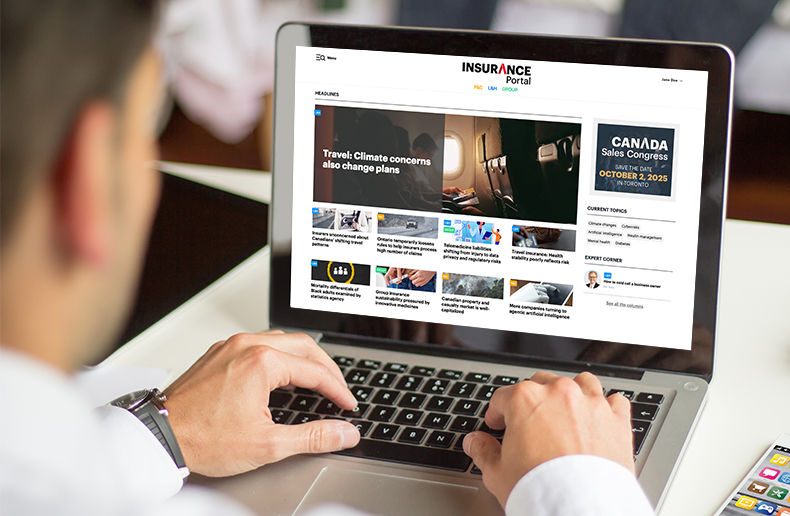Flexible universal life products roared to popularity in the 1990’s, leaving traditional whole life insurance products in the shadows. Since the bursting of the technology bubble in 2000, however, whole life has been steadily making its way back into the limelight with positive growth year after year. Stock market turbulence in 2008 drove this trend even higher upwards as consumers were increasingly attracted by the product’s simplicity and guarantees.
In 2008, whole life sales were up 13% year-over-year among the 20 Canadian insurers and two subsidiaries that participate in LIMRA International's individual life insurance sales survey. These companies represent over 93% of the market. In 2007, whole life sales grew by 10% and in 2006 by 5%, according to previous LIMRA reports.
Meanwhile, the 2008 LIMRA report showed that universal life (UL) sales were down 3% year-over-year. "With the detrimental performance of stock market indices, consumers continued to stray away from the purchase of universal life," the report stated.
LIMRA defines whole life "as any traditional cash-value life insurance policy, such as whole life continuous pay, limited pay, modified, enhancement, and current-assumption life."
Whole life insurance provides permanent coverage to the insured and builds up cash values. Non-participating (non-par) contracts feature level premiums for the insured's lifetime or during a pre-determined payment period. Participating (par) whole life policies offer the same benefits but also may pay dividends to the policyowner based on the insurer's profits.
Saundra Edwards, Assistant Vice President, Individual Life Insurance Marketing, for Great-West Life, Canada Life and London Life, cheers the fact that whole life products are reclaiming a place on centre stage. The Great-West companies offer whole life participating (par) products and experienced a 22% sales increase in this product line last year with $122 million in par whole life premium sales. In 2008, the Great-West companies held the number one position in the par whole life market with 48% market share.
The trend appears to be accelerating. For the first two months of 2009, the Great-West companies had posted a 30% sales increase for their whole life products compared to the same period one year earlier.
"What we've seen recently, with the markets, is that a lot of advisors are rethinking and going back to good old fashioned participating whole life," says Ms. Edwards.
In 2005, Standard Life Canada took its non-par whole life product off the market to focus its resources on its UL offering. But, prompted by a request from the field, the insurer re-entered the whole life market in June 2008 with a redesigned and fully guaranteed non-par whole life product, which is simply called Whole Life.
Gerry Anthony, Senior Consultant, Product Development, Insurance, Retail Markets at Standard Life says, "We reintroduced our whole life product because we felt there was a market for it and it appears that we were right in that regard. I like to think it was great planning, but our timing was probably fortuitous."
Sales statistics are preliminary, but Mr. Anthony says they are "trending upward." A number of advisors have expressed that they are "extremely pleased to see it back in the market," he adds.
Market volatility
Bob Dickson, a financial advisor from Carleton Place, Ontario says the market situation is a concern for anyone who has been selling a lot of universal life with an equity-based investment component. "I am sure they're all concerned." Mr. Dickson has sold a few such policies, but he is an advocate of non-par whole life products for his clientele over the age of 45 who are realizing that term insurance is getting costlier. With non-par whole life, "I get the lowest cost (permanent) life insurance for my client. I can sell it and say it's fully guaranteed."
Not only that, but he finds the simplicity of this product attractive. He cites the straightforward annual statement and adds that selling the product doesn't require providing the client with pages upon pages of disclosure documents like with UL. "Whole life is good simple coverage."
He also says it is much easier for advisors to understand whole life insurance than UL. "I won't sell what I don't understand."
Peter Wouters, Director, Tax and Estate Planning and Director of Retail Risk Product Marketing at Empire Life, says that his company saw the trend toward whole life products and repriced its par product at the end of last summer to make it more competitive. It kept its guaranteed cash values exactly the same and lowered the rate.
The result is that sales rose 15% in the last quarter of 2008.
Empire is one of the few companies that offers both par and non-par whole life products.
Stock market turbulence has sparked the trend toward whole life, Mr. Wouters affirms. "It's not just a flight to quality, but a flight to certainty. We're living in some pretty complicated times. Nothing seems predictable anymore."
The trend has also been driven by a renewed interest in traditional bundled solutions that do not require investment decision-making. Because of the market instability, consumers are looking for four things in a financial solution: simplicity, quality, peace of mind and predictability, says Mr. Wouters. Whole life has all of these qualities, he adds.
Universal life products, on the other hand, are unbundled solutions which require some investing decisions on the part of the policyholder.
Ms. Edwards of Great-West says that while she doesn't think consumers necessarily go to their advisor asking for a particular product, she does think that they are enticed by whole life when an advisor presents its advantages. "I do think that par whole life and its features speak very well to consumers in this day, with the market volatility that we've seen...Definitely in times of market volatility, the benefits of participating whole life insurance do shine. It's the only product where the cash value will increase every year."
When clients open up their annual statements, they do not see a decrease in the values as with many other investments, but they actually see an increase over the previous year, she adds. "Certainly, in these times, that is a very strong message with clients."
Mr. Wouters of Empire also mentions that clients are impressed when they open up their annual statements and see that the values have risen. Clients say, "That's attractive...Give me some of that."
Mr. Anthony of Standard Life agrees that market volatility is behind the present spike in sales. "People who may have purchased or considered purchasing a universal life or variable product [now] after the meltdown, are looking for something a bit more stable that is guaranteed. I think that's why there is a trend towards it."
Steady growth
Ms. Edwards underlines that while there has been a marked increase in par whole life sales due to stock market troubles in recent months, whole life par has in fact experienced steady sales for the past five years at Great-West's companies.
She explains this steady growth by its appeal to high net worth clients, business owners and individuals who have significant exposure to the equity markets and higher risk investments. The par account has a fixed income asset mix that for many years has provided strong, stable, historical returns, which can provide good diversification for individuals with significant high-risk investments, such as non-registered investments in a business, Ms. Edwards explains.
She adds that the Great-West companies have also seen a steady increase in average par premiums over the last 10 years. "In 2008, the average premium per sale was in excess of $4000."
Universal life sales down
The Great-West companies' universal life sales took a hit last year, declining 13%. Ms. Edwards says that part of this decline is accounted for by advisors moving their sales to traditional products such as whole life or term insurance (term premiums were up 37% in 2008). "Because we do have a complete product shelf - term, UL and participating whole life - advisors are able to shift their sales away from UL or other solutions during times like this."
Mr. Anthony sees the same trend toward traditional products with respect to new sales. Economic trends will do one of two things, he explains. Either people will come back to more traditional guaranteed products, "or because of economic circumstances probably, we're seeing an increase also in term insurance sales." The term hike is due primarily, to the affordability and the majority of term products on the marketplace, including Standard Life's, are convertible into a permanent plan once people can afford to do so when economic circumstances change, he adds.
As for the decline in UL, he says there are two types of products and they've been affected differently by the market troubles. While people may be still buying UL contracts, because of the market conditions they are not excess funding the contracts which brings down premium volume. "In other words they're just buying the barebones contract for protection purposes."
The LIMRA report confirms this observation. It shows that while UL sales are down in terms of premiums, they have remained stable in terms of the number of policies sold in 2008 compared to 2007.
Mr. Wouters of Empire Life says the new Tax Free Savings Accounts are also taking a bite out of universal life premiums. Before excess funding a UL contract, clients will first fund their TFSAs to the maximum. "That's a no-brainer."
As an advisor, Mr. Dickson says he is concerned that the number of insurers in the whole life market seems to be decreasing. He was especially concerned about Transamerica Life Canada's recent announcement that it has closed its non-par whole life product. He worries that others will do the same. "I see them slowly disappearing...It's a trend that the product is disappearing. I don't know why. UL is so fraught with difficulties," he says, observing that Canada Life also left the non-par whole life market two years ago.
Meanwhile, Manulife Financial left the par whole life market last year. Others have also left the par market in recent years, especially after a number of insurers demutualized, noted Ms. Edwards of Great-West. "At the time they demutualized, many got out of participating market...others got out later." The Great-West companies are committed to the par market, she assured.
Mr. Anthony of Standard Life agrees that there is definitely a reduction in par companies in the market and the number of par products as well, although he thinks this situation might be stabilizing. Standard Life, though, has no intention of reintroducing a par product. Its former participating policies, called the Designer Series, were withdrawn from the market in April 2003.
Withdrew from par market
"When we withdrew from the par market, the main reason for it was that we were unable, at that time, to compete with companies that had been around [longer]." Standard Life came out with a par product in 1992 and a lot of companies had very mature par products and were able to deliver rates on their dividend scales that Standard Life was unable to compete against," he explains. "I think what is happening in the market place now is you'll probably see par product dividend scales reducing over time because of the conditions in the marketplace. Long-term investments are not readily available these days with a liquid rate of return."
He adds that Standard Life is committed to maintaining its new non-par product. "We don't reintroduce or withdraw products without giving due consideration to it. It's our intention to maintain our product in the marketplace and hopefully as time goes by, depending on demand and our distributors commentaries, to maybe make changes to it." These changes may include adding earlier premium payment options, he says.
Meanwhile, the Great-West companies are not interested in the non-par market. Ms. Edwards says that Canada Life did withdraw its T100 product about two years ago. This was a non-par whole life product, if you consider that age 100 is a whole life product. She explains that sales in the industry for standalone T100 products have been shrinking for the last 10 years. "I think if I remember correctly, they accounted for less than 1% of premiums sold in Canada last year."
Ms. Edward adds that universal life is a good alternative to non-par whole life products since it offers both permanent insurance and added flexibility. In recent years, many advisors have chosen to sell universal life over T100 even it was on a minimum funded basis, which explains the decline in T100 sales and Canada Life's decision to leave that market. "Strategically you have to look at where you want to spend your money, and where you want to invest, and which product is growing in the market place."
Younger advisors
While whole life sales are climbing in the industry, younger advisors are not doing much of the selling, Mr. Wouters observes. "There is a whole generation that have never been exposed to it. They've never sold it."
In the last decade or so, life insurance has often been sold as an investment rather than for its traditional purpose, he adds. "Most advisors these days are selling investments not insurance. If they are selling insurance they are selling term insurance. If they want to be fancy about it, they are selling universal life," which is like buying term and investing the difference wrapped up in one product. "They (advisors) kind of leave everything else alone."
But, with what has been happening in the stock market, Mr. Wouters says clients are looking for simpler insurance solutions. "I think with this market, there is kind of a call back to some basics, some real basics."
Just as they seek to diversify clients' investments, he says advisors should also diversify their clients' risk coverage and one way they can do this is by taking a good look at whole life. "If I realize that there are many more tools and options in my quiver, maybe I should be exploring some of them. What whole life allows you to do is offer people some simplicity and predictability that may not exist with the other products."
To help raise awareness among advisors of insurance basics, Empire Life is developing marketing material to discuss various types of products and how appropriate they may be at any point in time. Getting back to basics is particularly important now because "...people are starting to redefine what risk really means," Mr. Wouters explains.
Mr. Anthony says the good news about selling this product for the first time is the gentle learning curve. Whole life is much easier to understand than universal life, he adds. "It's got very little variability to it. What you see is what you get. You pay a premium and the contract contains a guaranteed set of values."






